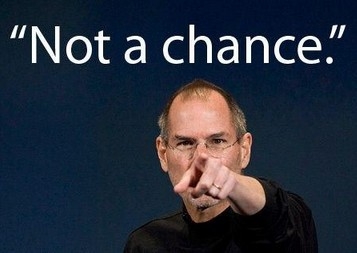The company had not only a new logo, but a new name. No longer was it Next. It was NeXT. Others might not have understood the need to obsess over a logo, much less pay $100,000 for one. But for Jobs it meant that NeXT was starting life with a world-class feel and identity, even if it hadn’t yet designed its first product. As Markkula had taught him, a great company must be able to impute its values from the first impression it makes.
公司現在不僅有了新的標識,還有了個新名字。它不再叫Next,而變成了NeXT。其他人也許還不明白重視標識的必要,更不會為了一個標識花上10萬美元。但對于喬布斯來說,一個好的標識意味著NeXT正在以世界級的感覺和身份起步,盡管它還沒有設計出自己的第一款產品。馬庫拉曾教過他,你可以根據封面去評價一本書,而一家偉大的公司必須從給人的第一印象就映射出自己的價值觀。從這一點來看,這個標識簡直酷斃了。
As a bonus, Rand agreed to design a personal calling card for Jobs. He came up with a colorful type treatment, which Jobs liked, but they ended up having a lengthy and heated disagreement about the placement of the period after the “P” in Steven P. Jobs. Rand had placed the period to the right of the “P.”, as it would appear if set in lead type. Steve preferred the period to be nudged to the left, under the curve of the “P.”, as is possible with digital typography. “It was a fairly large argument about something relatively small,” Susan Kare recalled. On this one Jobs prevailed.
作為免費贈品,蘭德同意為喬布斯設計個人名片。蘭德想出了一個顏色豐富的解決方案,喬布斯很喜歡;但是在“SteveP.Jobs”這個名字中字母P后面的縮寫符位置問題上,兩人產生了長久而激烈的分歧。蘭德想把縮寫符的位置靠右放一點兒,這樣用鉛字印刷的時候,這個符號就會比較清晰。史蒂夫比較喜歡縮寫符離P更近一點兒,就放在“P”的曲線下,比較適合數字排版。“就這樣,一件小事情引發了非常大的爭論。”蘇珊·卡雷回憶道。這一次,喬布斯占了上風。
In order to translate the NeXT logo into the look of real products, Jobs needed an industrial designer he trusted. He talked to a few possibilities, but none of them impressed him as much as the wild Bavarian he had imported to Apple: Hartmut Esslinger, whose frogdesign had set up shop in Silicon Valley and who, thanks to Jobs, had a lucrative contract with Apple. Getting IBM to permit Paul Rand to do work for NeXT was a small miracle willed into existence by Jobs’s belief that reality can be distorted. But that was a snap compared to the likelihood that he could convince Apple to permit Esslinger to work for NeXT.
為了將NeXT標識完全體現在真實的產品中,喬布斯需要一位值得信任的工業設計師。他和幾位可能的人選談了談,但是沒有人比他推薦給蘋果公司的巴伐利亞狂人哈特穆特·艾斯林格更合適。艾斯林格的青蛙設計公司在眭谷設有工作室,由于喬布斯的緣故,斯林格和蘋果公司簽訂了合同,收入頗豐。說服IBM公司允許保羅·蘭德為自己設計NeXT標識,是喬布斯相信現實能被意志扭曲的一次小小奇跡。然而,與接下來說服蘋果允許艾斯林格為NeXT工作相比,這要算是很容易的事情了。
This did not keep Jobs from trying. At the beginning of November 1985, just five weeks after Apple filed suit against him, Jobs wrote to Eisenstat and asked for a dispensation. “I spoke with Hartmut Esslinger this weekend and he suggested I write you a note expressing why I wish to work with him and frogdesign on the new products for NeXT,” he said. Astonishingly, Jobs’s argument was that he did not know what Apple had in the works, but Esslinger did. “NeXT has no knowledge as to the current or future directions of Apple’s product designs, nor do other design firms we might deal with, so it is possible to inadvertently design similar looking products. It is in both Apple’s and NeXT’s best interest to rely on Hartmut’s professionalism to make sure this does not occur.” Eisenstat recalled being flabbergasted by Jobs’s audacity, and he replied curtly. “I have previously expressed my concern on behalf of Apple that you are engaged in a business course which involves your utilization of Apple’s confidential business information,” he wrote. “Your letter does not alleviate my concern in any way. In fact it heightens my concern because it states that you have ‘no knowledge as to the current or future directions of Apple’s product designs,’ a statement which is not true.” What made the request all the more astonishing to Eisenstat was that it was Jobs who, just a year earlier, had forced frogdesign to abandon its work on Wozniak’s remote control device.
但這并沒有阻止喬布斯去嘗試。1985年11月初,蘋果對喬布斯提起訴訟5周后,喬布斯就寫信給艾森斯塔特(蘋果公司法律總顧問,訴訟由他發起),要求取消訴訟。“我這周同哈特穆特·艾斯林格聊過,他建議我給你寫一封信,表達我想同他及青眭設計公司合作NeXT新產品的原因。”喬布斯寫道。令人驚訝是,喬布斯的說法是,他自己不知道蘋果公司正在做的東西,但是艾斯林格知道。“NeXT對于蘋果公司產品設計現在和未來的方向都一無所知。如果我們和其他那些同樣對蘋果不了解的設計公司合作的話,那就有可能會不經意地設計出外觀類似的產品。而哈特穆特他們了解蘋果,能夠確保不會讓設計與蘋果的產品類似,因此這對蘋果公司和NeXT公司都最有利。”艾森斯塔特回憶,自己為喬布斯的厚顏無恥瞠目結舌,他對此作出了簡短的回復。“我曾代表蘋果公司表達過擔憂,你所從事的業務會利用蘋果公司的機密商業信息。”他寫道,“你的信函無論如何無法減輕我的憂慮。事實上,它加深了我的擔憂,因為你在信中表示自己‘對蘋果公司產品設計現在和未來的方向一無所知’,而這一說法并非事實。”更令艾森斯塔特驚訝的地方在于,就在一年前,喬布斯本人就曾強迫青蛙設計公司放棄沃茲尼亞克遙控裝置的項目。
Jobs realized that in order to work with Esslinger (and for a variety of other reasons), it would be necessary to resolve the lawsuit that Apple had filed. Fortunately Sculley was willing. In January 1986 they reached an out-of-court agreement involving no financial damages. In return for Apple’s dropping its suit, NeXT agreed to a variety of restrictions: Its product would be marketed as a high-end workstation, it would be sold directly to colleges and universities, and it would not ship before March 1987. Apple also insisted that the NeXT machine “not use an operating system compatible with the Macintosh,” though it could be argued that Apple would have been better served by insisting on just the opposite.
喬布斯意識到,為了同艾斯林格合作(以及各種其他原因),必須解決蘋果公司的訴訟。幸運的是,斯卡利愿意考慮撤銷訴訟。1986年1月,他們達成庭外和解,不涉及經濟損失。為了回報蘋果公司放棄訴訟,NeXT公司同意了種種限制條款:其產品將作為髙端智能終端直接銷售給髙校,而且NeXT公司不能在1987年3月之前推出產品。蘋果公司還堅持,NeXT的機器“不能使用與麥金塔兼容的操作系統”。后來的情況表明,如果當時蘋果公司的要求剛好相反,會對自身更為有利。
After the settlement Jobs continued to court Esslinger until the designer decided to wind down his contract with Apple. That allowed frogdesign to work with NeXT at the end of 1986. Esslinger insisted on having free rein, just as Paul Rand had. “Sometimes you have to use a big stick with Steve,” he said. Like Rand, Esslinger was an artist, so Jobs was willing to grant him indulgences he denied other mortals.
訴訟解決后,喬布斯繼續游說艾斯林格,直到這位設計師決定終止與蘋果公司的合同。1986年底,青蛙設計公司終于能夠同NeXT合作了。艾斯林格堅持完全的自由,就像保羅·蘭德一樣。“有時候,你必須對史蒂夫采用大棒政策。”他表示。和蘭德一樣,艾斯林格是一位藝術家,所以喬布斯也愿意放任他自由設計,其他人可享受不到這種待遇。
Jobs decreed that the computer should be an absolutely perfect cube, with each side exactly a foot long and every angle precisely 90 degrees. He liked cubes. They had gravitas but also the slight whiff of a toy. But the NeXT cube was a Jobsian example of design desires trumping engineering considerations. The circuit boards, which fitted nicely into the traditional pizza-box shape, had to be reconfigured and stacked in order to nestle into a cube.
喬布斯規定,計算機必須是絕對完美的立方體,每條邊都正好一英尺長,每個角都是90度。他喜歡立方體,它們莊嚴但也有玩具的感覺。但是,NeXT立方體是喬布斯式功能適應形式的例子,而非形式順應功能的設計,后者是包豪斯設計理念及其他功能設計師所強調的。本來電路板能夠很好地契合傳統的比薩餅盒的形狀,但在NeXT電腦這里,為了適應立方體的結構,電路板必須重新配置和安裝。











